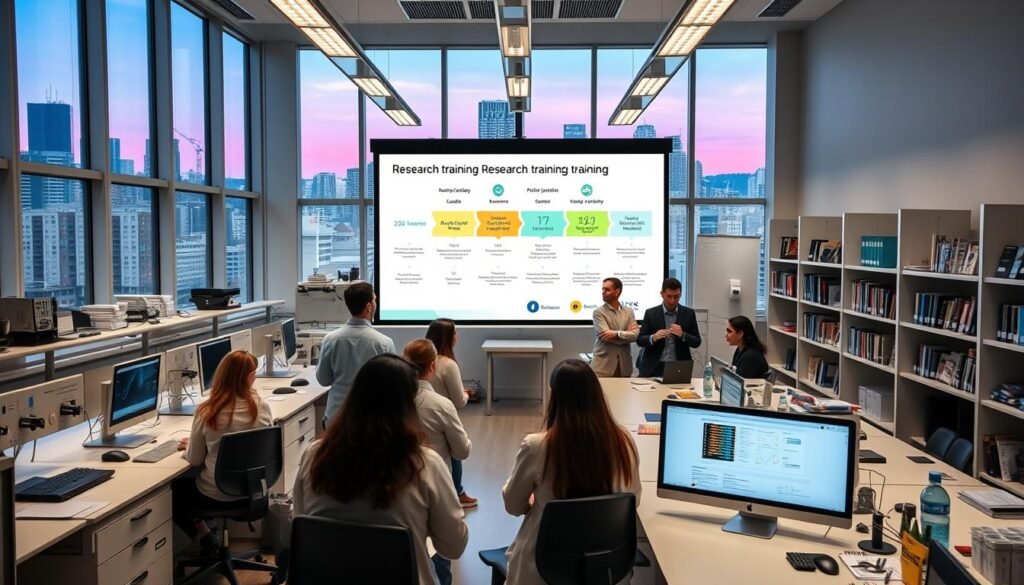
You may be juggling a job, family or the steady hum of life while you think about postgraduate study. That hush of excitement mixed with worry about fees, living costs and timelines is familiar to many students who plan a higher degree by research.
This guide gives you practical, clear information about scholarships, fee offsets and living stipends so you can plan with confidence. It draws on examples from top universities to show typical amounts and what is usually included.
You’ll read about how a scholarship can cover tuition and help with day-to-day costs while you study full time. You’ll also see how support works for both domestic and international candidates, including health cover for visa holders.
By the end of this section you should feel ready to map funding to your study and career goals, and know the next steps for applications and enquiries.
Research Training Program (RTP) overview for postgraduate research in Australia
Understand the two main funding streams that most universities use to support postgraduate candidates.
Fee offset usually covers tuition in full for eligible domestic and some international candidates. Coverage commonly maps to your degree type for example, up to 14 research periods at the University of Sydney or typical durations at the University of Melbourne for masters and doctoral study.
Stipend awards provide a living allowance and are offered competitively. 2025 examples include $41,753 p.a. at the University of Sydney and $38,500 p.a. at the University of Melbourne. These amounts are typically indexed annually and include limited paid leave.
International students often receive Overseas Student Health Cover when a visa requires it. That cover sits alongside tuition remission and any living allowance you receive.

- Two pillars of support: fee offset and living stipend, which can be combined.
- Stipends are merit-based; selection panels assess academic results and potential.
- Tuition coverage length depends on degree type and university rules.
- Multiple university schemes follow these same principles for 2025 research funding.
| Support type | Typical benefit | 2025 example |
|---|---|---|
| Fee offset | 100% tuition coverage for set research periods | Up to 14 periods (University of Sydney) |
| Stipend | Living allowance, indexed annually | $41,753 p.a. (Sydney) / $38,500 p.a. (Melbourne) |
| OSHC | Health cover for visa-holding students | Included for eligible international offers |
| Duration | Matches degree: masters or doctoral research length | Masters: ~2 years; PhD: ~3–4 years (varies) |
What to do next: check admission deadlines and the scholarship application steps at your chosen university so you can prepare documents and apply on time.
Benefits, rates and fee offsets you can access in 2025
Knowing the 2025 stipend rates and what is included makes budgeting and planning your move far easier.
RTP stipend scholarship: living allowance and 2025 rate
Sydney: a full-time stipend of $41,753 p.a. (2025 rate). Recipients often get relocation and thesis allowances alongside the cash award.
Melbourne: a full-time stipend of $38,500 p.a. (2025 rate). Support is offered for up to two years for a masters by research and up to 3.5 years for a doctoral degree.
RTP fee offset: 100% tuition coverage and duration
Many stipend winners also receive a full fee offset. At Sydney, that covers 100% tuition for up to 14 research periods.
Melbourne offers fee remission up to two years for masters and up to four years for doctoral candidates.

Overseas Student Health Cover for international students
International students receive OSHC when a student visa requires it. This is commonly bundled with stipend and fee remission offers.
Relocation and thesis allowances to support your move and completion
Relocation grants ease the cost of moving. Melbourne lists $2,000 for interstate moves and $3,000 from overseas.
Thesis allowances and limited paid leave help you finish on time.
- Compare stipend rates to budget realistically: Sydney $41,753; Melbourne $38,500 (both indexed).
- Confirm whether a stipend automatically includes a fee offset Sydney usually pairs them.
- Check leave entitlements and completion grants when you accept an award.
| Benefit | Sydney (2025) | Melbourne (2025) | Notes |
|---|---|---|---|
| Stipend (full-time) | $41,753 p.a. | $38,500 p.a. | Indexed annually; helps living costs |
| Fee offset | 100% tuition, up to 14 periods | Full remission: Masters 2 yrs; PhD up to 4 yrs | Check your offer for exact coverage |
| Relocation grant | Relocation and thesis allowances (varies) | $2,000 interstate; $3,000 overseas | Helps with moving costs |
| OSHC | Included for eligible international students | Single membership for visa holders | Usually bundled with the award |
For detailed eligibility and to compare specific offers, check your chosen university’s HDR scholarships page such as HDR scholarships and the scholarship terms in each offer.
Eligibility and selection: who qualifies and how you’re assessed
Before you apply, check whether your status as a domestic or international candidate affects fee remission and stipend eligibility.
Domestic and international student pathways
Domestic or international pathways
Your category domestic or international sets the likely offer mix. Some universities provide fee offsets broadly to eligible domestic students. Stipend packages are usually competitive and open to top-ranked domestic and international applicants.
Academic merit, research experience and panels
What selection panels look for
Panels weigh your degree result, prior research experience and outputs. Evidence can include honours projects, refereed publications, industry reports and relevant professional work.
- Commencing and currently enrolled candidates may both be eligible.
- Selection focuses on academic merit and research potential.
- Tailor your application to highlight your best research experience and referees.
| Applicant type | Typical eligibility | Typical outcome |
|---|---|---|
| Domestic commencing | Meeting entry scores and enrolment criteria | Fee offset often available; stipend competitive |
| International commencing | High academic record and strong proposal | Fee offset or stipend offers for top candidates |
| Currently enrolled | Must follow university application process | Considered for scholarships if eligible |
Tip: check the university’s scholarship terms and align your application with the panel’s priorities.
How to apply for admission and scholarships
Applying on time sets the foundation for admission offers and scholarship consideration across most Australian universities. Start by checking the course closing date and the scholarship round dates for your chosen school.
New applicants: automatic consideration and admission deadlines
At some institutions, new applicants who apply for admission by the closing date are automatically considered for graduate scholarships, including rtp awards. That means if you lodge your admission application before the cut-off you may not need a separate scholarship form.
Currently enrolled or deferred students: you must submit the application form
If you are currently enrolled or have deferred, you must submit the online application form by the deadline to be considered. The University of Sydney, for example, requires a scholarship form plus supporting documents from enrolled candidates.
Required documentation: research experience evidence and templates
Prepare transcripts, a clear proposal, supervisor endorsements and a completed research experience Word template where provided. Use the template and appendix guide to present your track record concisely.
Offer process, status updates and university communications
Domestic fee offsets may appear with your course offer; stipend decisions are usually issued around the same time. Track your application status via the admissions portal and email the graduate scholarships team if you have questions.
Key dates and timelines for 2025-2026 intakes
Plan your 2025–26 intake by working backwards from the submission cut-offs and outcome windows that apply to your pathway.
Domestic research periods: submission deadlines and outcome windows
Domestic applicants should note Sydney example dates to plan. For 2025 Research Periods 1–2 the submission deadline was 23 Oct 2024 and outcomes began 13 Dec 2024. Periods 3–4 closed 5 May 2025 with results from 13 Jun 2025 and received notices by 24 Jun 2025.
International research periods: application cut-offs and result dates
International students follow earlier cut-offs. Examples: Research Periods 1–2 (2025) closed 13 Sep 2024 with outcomes from 22 Nov 2024. Periods 3–4 (2025) closed 17 Dec 2024 with outcomes from 10 Mar 2025 and received by 19 Mar 2025.
Understanding start dates, duration and commencement
Start dates map to research periods and affect stipend and fee duration. For planning, allow time to contact supervisors, submit an application form and respond to status requests from the university.
- Map your target intake and work back to the submission date.
- Expect outcome windows a few weeks after the cut-off; domestic and international cycles differ.
- Factor visa lead times, OSHC and any fee payments before enrolment.
| Pathway | Example submission date | Outcome window | Typical action |
|---|---|---|---|
| Domestic | 23 Oct 2024 / 5 May 2025 | From 13 Dec 2024 / 13 Jun 2025 | Prepare transcripts; submit application form |
| International | 13 Sep 2024 / 17 Dec 2024 | From 22 Nov 2024 / 10 Mar 2025 | Allow extra time for visa and OSHC |
| Next intake (2026) | 10–12 Oct 2025 / 19 Dec 2025 | From Nov 2025 – Feb 2026 (est.) | Confirm exact dates with your chosen school |
Scholarship terms, conditions and where to get help
Know the fine print of scholarship offers so you can plan leave, study milestones and budget with confidence.
Stipend indexing, leave entitlements and fee remission periods
How your allowance changes and what leave you can take matter for timing and cashflow.
- Indexing: stipends are often adjusted yearly; check the current rate in your offer.
- Leave entitlements: limited paid sick, maternity and parenting leave may apply.
- Fee remission: Melbourne covers up to two years for a masters and up to four years for a doctoral degree; Sydney commonly links a stipend with a full fee offset (100% tuition up to 14 research periods).
- What students receive: relocation and thesis allowances, plus OSHC for visa holders in some offers.
Related documents, policies and who to contact with questions
Read the Graduate Research Scholarships Terms & Conditions and the HDR selection process documents to understand obligations and eligibility.
Use the research experience evidence Word template and appendix guide to present your track record for selection panels.
If you have questions, contact the university scholarships or HDR team. For more general HDR scholarships information see HDR scholarships.
Ready to take the next step in your research career
Take a practical step now: shortlist target universities and the scholarships that match your degree and career aims, then lock in key dates.
Line up your evidence, confirm referee details and polish a concise proposal that shows clear research intent. Check whether automatic consideration applies or if you must submit a separate form.
Map the likely funding mix stipend, fee offset, OSHC if relevant, and any relocation or thesis support — so you can compare offers fairly.
Plan to engage supervisors early and use researcher development opportunities while you study to strengthen outcomes and meet milestones.
For practical guidance on HDR scholarship pathways, see HDR scholarship pathways and move forward with confidence.